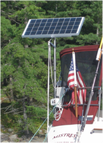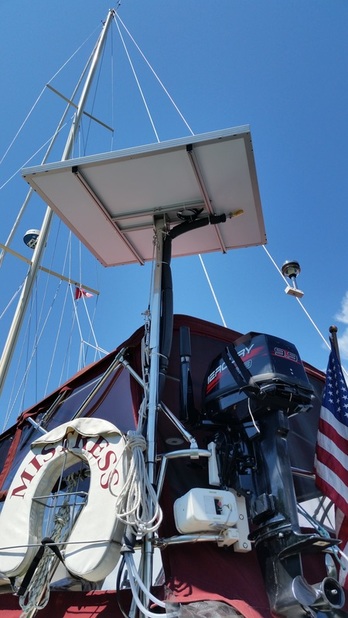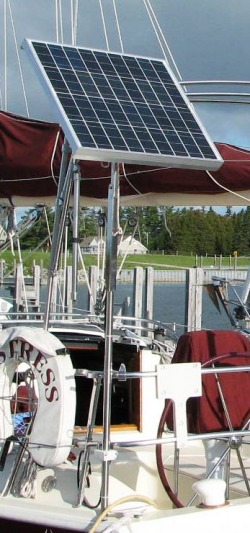 This year we tested our new 175 Watt SunPower cell solar panel with our integrated water heating system on a 6 week cruise in Northern Lake Huron at a latitude of about 46 degrees. We used an EP Xtra-N 20 amp MPPT Controller. The 175 watt panel provided plenty of power to meet our 70 amp hour per day requirements. The 175 watt panel was mounted using our CMP pole mounting system so I could tilt and rotate the panel to achieve optimum sun angle. I set the sun angle once and rotated the panel three times a day (morning, midday, evening) and estimate we got about 30% more performance over a fixed horizontally mounted panel. Operating statistics: Our power usage averaged approximately 70 amp hours or 850 watt hours in a 24 hour period. Our current draw was from a refrigerator/freezer running 24/7, our LED lights in the evening, cell phone chargers, laptop computer several hours a day and our radios and instruments during the day. Our windlass is only run when the engine is running so we don't include it in our power consumption calculation as the alternator quickly makes up for its power usage. We have a 75 amp Balmar alternator with a smart regulator. We changed our battery system this year by installing two 100 amp hour CMP LiFePo4 batteries for our house bank and one for our starting battery. I will post more about these batteries and our exciting findings soon. We started the engine to move anchorages about every three days. Results and findings: 1. Our battery bank was fully charged by 1 PM most sunny or mostly sunny days when at anchor. This is about the same charging time that we experienced last year with the 160 watt solar panel. 2. The EP Xtra-N MPPT controller with the remote display proved to be an outstanding piece of equipment. It was simple to program, easy to read, collected the appropriate data and was very efficient. It was exciting (I get excited about these things) to see 6 to 10 amps being poured into the battery bank in the morning. It would be frustrating to see it only outputting and amp or two in the afternoon in full sun but then you realize it is doing its job. It fully charged the batteries in the morning and was in float mode topping off the battery bank in the afternoon. 3. Because we have excess power in the afternoon on sunny days, we installed an inverter and purchased an ice maker. This turned out to be worthwhile purchase. Ice for drinks was a free luxury (power wise) that we really enjoyed. 4. Rotating the panel during the day, especially in the morning, significantly increased the power generation of the panel. 5. The data gathered confirmed that this panel configuration supplied all the power we needed and had excess capacity to catch up on battery charge after a string of cloudy days. 6. The panel was affected by shading as would be expected. Occasionally the panel was shaded by the back stay or the mast. While the shading was minimal, it degraded the performance by up to 40%. 7. We installed a new larger heat exchanger on the back of the panel for our water heating system This worked well on those sunny days so we had warm water for showers and dish washing. Power consumption of this system was minimal. Data: 175 Watt Solar Panel At anchor Motor Sunny to Cloudy to Mostly Sunny Mostly Cloudy Average watt hrs per day 750 480 900 435 Average amp hours per day 58 37 69 33 Maximum watt output in 24 hours 1,280 750 1,280 570 Maximum amp hours in 24 hours 98 58 98 44 160 Watt Solar Panel At anchor Motor Sunny to Cloudy to Mostly Sunny Mostly Cloudy Average watt hrs per day 660 480 700 400 Average amp hours per day 51 37 54 31 Maximum watt output in 24 hours 1,210 770 1,210 770 Maximum amp hours in 24 hours 93 59 93 59 Observations: 1. The minimum watt hour output doesn't mean much because it is dependent on both the cloud cover and the state of charge of the bank as a result of alternator charging, 2. The maximum watt hours per day of 1,280 is not the maximum output capacity of the system in a 24 hour period because the batteries were charged by 1 PM so the controller shut down the charge from the panel. A higher drain on the house battery bank would have resulted in this number being higher. 3. Average amp hours per day is computed by dividing the watt hours by 13 volts. This is a ballpark calculation. 4. This configuration proved to have plenty of capacity for our cruising needs even without using an auxiliary flexible solar panel we store under a bunk. We did not use shore power to charge our battery bank for the entire summer. Solar Water Heater: We installed our new solar water heating system. It consists of a heat collector or heat exchanger mounted on the back of the solar panel, and a circulating pump. See our earlier blog for design considerations. The pump circulates water from the water heater through the heat exchanger on the panel. We used the same configuration on our 120 watt panel last year. Results: On sunny days at anchor we had warm water for showers and dish washing. The water temperature in our 6 gallon hot water tank would warm from 60 degrees to about 105 degrees in 2-3 hours on a sunny calm day. As expected, we confirmed that strong winds tend to cool the panel and reduce the heating efficiency as do clouds. Overall, the water heating system cools the surface of the panel by at least 20 degrees. This increases the efficiency of the panel since solar panel performance degrades as they are heated by the sun. Insulating the tubing running between the heat exchanger and the water heater significantly increased the efficiency of the system. In conclusion, the radiant energy water heating system works well on sunny days with both our larger and our standard sized panels. See our product section or read our earlier blog for details.
0 Comments
This year we tested our new 160 Watt SunPower cell solar panel with our integrated water heating system on a 6 week cruise in Northern Lake Huron at a latitude of about 46 degrees. We used an EP Tracer BN 20 amp MPPT Controller. The 160 watt panel provided plenty of power to meet our 70 amp hour per day requirements. The 160 watt panel was mounted using our CMP pole mounting system so I could tilt and rotate the panel to achieve optimum sun angle. I set the sun angle once and rotated the panel three times a day (morning, midday, evening) and figure I got about 30% more performance over a fixed horizontally mounted panel.
Operating statistics: Our power usage averaged approximately 70 amp hours or 850 watt hours in a 24 hour period. Our current draw was from a refrigerator/freezer running 24/7, our LED lights in the evening, cell phone chargers, laptop computer several hours a day and our radios and instruments during the day. Our windlass is only run when the engine is running so we don't include it in our power consumption calculation as the alternator quickly makes up for its power usage. We have a 75 amp Balmar alternator with a smart regulator. Our house bank consists of 3 flooded cell batteries giving us a total capacity of 330 amp hours. We started the engine to move anchorages about every three days. Results and findings: 1. Our battery bank was fully charged by 1 PM most sunny or mostly sunny days when at anchor. This is in contrast to 2 PM in last year using our 120 watt panel on a pole. 2. The EP Tracer BN MPPT controller with the remote display proved to be an outstanding piece of equipment. It was simple to program, easy to read, collected the appropriate data and was very efficient. It was exciting (I get excited about these things) to see 9+ amps being poured into the battery bank in the morning. It would be frustrating to see it only outputting and amp or two in the afternoon in full sun but then you realize it is doing its job. It fully charged the batteries in the morning and was in float mode topping off the battery bank in the afternoon. 3. Rotating the panel during the day, especially in the morning, significantly increased the power generation of the panel. 4. The data gathered confirmed that this panel configuration supplied all the power we needed and has excess capacity to catch up on battery charge from a string of cloudy days. 65. The panel was affected by shading as would be expected. Occasionally the panel was shaded by the back stay or the mast. While the shading was minimal, it degraded the performance by up to 40%. Data: At anchor Motor Sunny to Cloudy to Mostly Sunny Mostly Cloudy Average watt hrs per day 1,047 645 700 220 Average amp hours per day 55 40 60 40 Maximum watt output in 24 hours 1,210 770 1,210 770 Maximum amp hours in 24 hours 100 64 100 64 Observations: 1. The minimum watt hour output doesn't mean much because it is dependent on both the cloud cover and the state of charge of the bank as a result of alternator charging, 2. The maximum watt hours per day of 1,210 is not the maximum output capacity of the system in a 24 hour period because the batteries were charged by 1 PM so the controller shut down the charge from the panel. A higher drain on the house battery bank would have resulted in this number being higher. 3. Average amp hours per day is computed by dividing the watt hours by 12 volts. This is a ballpark calculation. 4. This configuration proved to have plenty of capacity for our cruising needs even without using an auxiliary flexible solar panel we store under a bunk. We did not use shore power to charge our battery bank for the entire summer. Solar Water Heater: We installed our new solar water heating system. It consists of a heat collector or heat exchanger mounted on the back of the solar panel, and a circulating pump. See our earlier blog for design considerations. The pump circulates water from the water heater through the heat exchanger on the panel. We used the same configuration on our 120 watt panel last year. Results: On sunny days at anchor we had warm water for showers and dish washing. The water temperature in our 6 gallon hot water tank would warm from 60 degrees to about 105 degrees in 2-31-2 hours on a sunny calm day. As expected, we confirmed that strong winds tend to cool the panel and reduce the heating efficiency as do clouds. Overall, the water heating system cools the surface of the panel by at least 20 degrees. This increases the efficiency of the panel since solar panel performance degrades as they are heated by the sun. Insulating the tubing running between the heat exchanger and the water heater significantly increased the efficiency of the system. In conclusion, the radiant energy water heating system works well on sunny days with both our larger and our standard sized panels. See our product section or read our earlier blog for details.  120 Watt Solar Panel on a Pole Mounting System with Water Heater and Crane Options 120 Watt Solar Panel on a Pole Mounting System with Water Heater and Crane Options This year we tested our new 120 Watt SunPower cell solar panel with our integrated water heating system on a 5 week cruise in Northern Lake Huron at a latitude of about 46 degrees. We used an EP 20 amp MPPT Controller. A 10 amp controller would have been sufficient but we wanted extra capacity so we could plug in an auxiliary 100 watt semi-flexible panel as a backup if we needed additional power because of a series of cloudy days. Plugging in an extra panel is simple using the MC4 connectors and an MC4 T-branch connector. We had mostly sunny days so we didn't need additional power beyond what the 120 watt panel provided. The weather was awesome! The 120 watt panel was mounted using our CMP pole mounting system so I could tilt and rotate the panel to achieve optimum sun angle. I set the sun angle once and rotated the panel three times a day (morning, midday, evening) and figure I got about 30% more performance over a fixed horizontally mounted panel. Operating statistics: Our power usage averaged approximately 70 amp hours or 850 watt hours in a 24 hour period. Our current draw was from a refrigerator/freezer running 24/7, our LED lights in the evening, cell phone chargers, laptop computer several hours a day and our radios and instruments during the day. Our windlass is only run when the engine is running so we don't include it in our power consumption calculation as the alternator quickly makes up for its power usage. We have a 75 amp Balmar alternator with a smart regulator. Our house bank consists of 3 flooded cell batteries giving us a total capacity of 330 amp hours. We started the engine to move anchorages about every three days. Results and findings: 1. Our battery bank was fully charged by 2 PM most sunny or mostly sunny days when at anchor. This is in contrast to 12-1 PM in past years using our 150 or 160 watt panels on poles. 2. The EP Tracer BN MPPT controller with the remote display proved to be an outstanding piece of equipment. It was simple to program, easy to read, collected the appropriate data and was very efficient. It was exciting (I get excited about these things) to see 8+ amps being poured into the battery bank in the morning. It would be frustrating to see it only outputting and amp or two in the afternoon in full sun but then you realize it is doing its job. It fully charged the batteries in the morning and was in float mode topping off the battery bank in the afternoon. 3. Rotating the panel during the day, especially in the morning, significantly increased the power generation of the panel. 4. Our weather was so sunny and the panel performed so well we had no reason to plug in the auxiliary 100 watt flexible panel using an MC4 T-branch for extra charging power. I plugged it in one morning just to confirm the configuration would work and was easy to do. It worked well and brought the charging amps to well over 12 amps. 5. The data gathered confirmed that this panel configuration supplied all the power we needed and has excess capacity to catch up on battery charge from a string of cloudy days. 6. The panel was affected by shading as would be expected. Occasionally the panel was shaded by the back stay or the mast. While the shading was minimal, it degraded the performance by up to 40%. Data: At anchor Motor Sunny to Cloudy to Mostly Sunny Mostly Cloudy Average watt hrs per day 740 540 650 290 Average amp hours per day 57 45 50 22 Maximum watt output in 24 hours 960 630 960 540 Minimum watt output in 24 hours 200 200 420 170 Observations: 1. The minimum watt hour output doesn't mean much because it is dependent on both the cloud cover and the state of charge of the bank as a result of alternator charging, 2. The maximum watt hours per day of 960 is not the maximum output capacity of the system in a 24 hour period because the batteries were charged by 2 PM so the controller shut down the charge from the panel. A higher drain on the house battery bank would have resulted in this number being higher. 3. Average amp hours per day is computed by dividing the watt hours by 13 volts. This is a ballpark calculation. 4. This configuration proved to have plenty of capacity for our cruising needs even without using the auxiliary solar panel. We have not used shore power to charge our battery bank for the entire summer. Solar Water Heater: We installed our new solar water heating system. It consists of a heat collector or heat exchanger mounted on the back of the solar panel, and a circulating pump. See our earlier blog for design considerations. The pump circulates water from the water heater through the heat exchanger on the panel. We used the same configuration on our 150 watt panel last year. Results: On sunny days at anchor we had warm water for showers and dish washing. The water temperature in our 8 gallon hot water tank would warm from 60 degrees to about 105 degrees in 2-3 hours on a sunny calm day. This was slower than the system we tested last year on our larger panel but it was perfectly adequate to meet our needs. As expected, we confirmed that strong winds tend to cool the panel and reduce the heating efficiency as do clouds. Overall, the water heating system cools the surface of the panel by at least 20 degrees. This increases the efficiency of the panel since solar panel performance degrades as they are heated by the sun. Insulating the tubing running between the heat exchanger and the water heater significantly increased the efficiency of the system. In conclusion, the radiant energy water heating system works well on sunny days with both our larger and our standard sized panels. See our product section or read our earlier blog for details.  Top-of-Pole Mount |
Categories
All
AuthorThomas Trimmer has been cruising with his Ericson 38 sailboat on the Great Lakes for over 20 years. He has pioneered the use of solar energy for wilderness cruising. He is continually designing and building equipment to simplify and enhance the cruising experience. Archives
April 2024
|
Efficiently Powering Your Vessel/Van. Call/email/chat any time, we're happy to help you work through designing your solar system.
Home Page Solar Panels Mounting Kits Product Page Marine Solar Systems Gallery of Installations Customer Comments Contact Us
Call 248 705-8337 or email [email protected]
Article On How To Size Your Solar Panels For Your Boat
Customer Reviews Return Policy Privacy Policy Shipping Times/Rates
Home Page Solar Panels Mounting Kits Product Page Marine Solar Systems Gallery of Installations Customer Comments Contact Us
Call 248 705-8337 or email [email protected]
Article On How To Size Your Solar Panels For Your Boat
Customer Reviews Return Policy Privacy Policy Shipping Times/Rates

 RSS Feed
RSS Feed